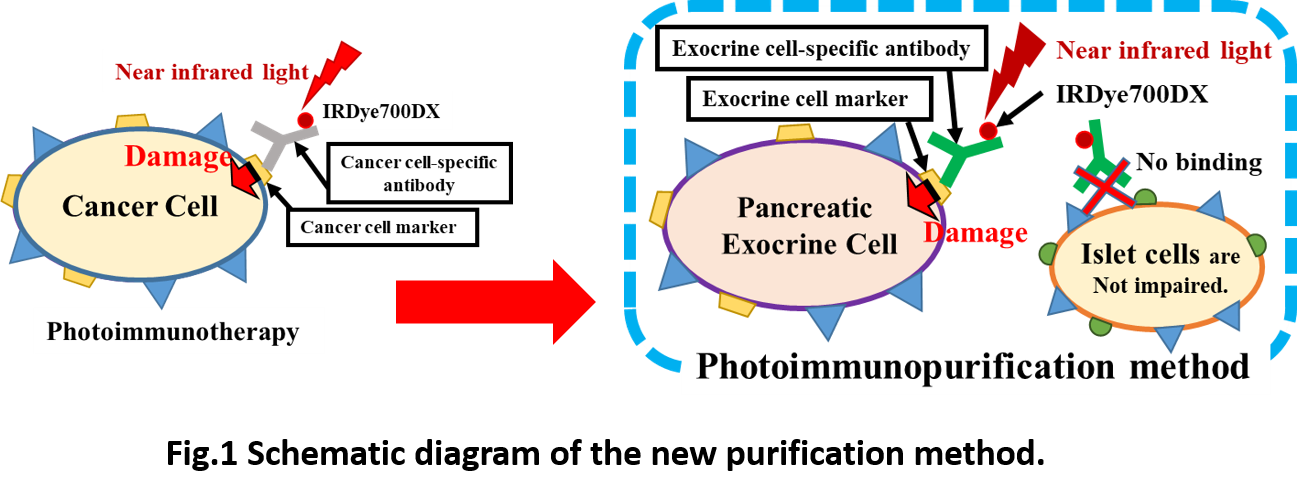New pancreatic islet purification method in pancreatic islet isolation applying photoimmunotherapy.
Koya Shinohara1, Masayuki Shimoda1.
1Department of Pancreatic Islet Cell Transplantation, Research Institute, National Center for Global Health and Medicine, Tokyo, Japan
The 'quantity' and 'purity' of the islets transplanted have a significant impact on the transplantation outcome of islet transplantation. On the other hand, the conventional 'purification' of islets by density gradient centrifugation based on the different densities between islets and exocrine cells does not allow many islets to be recovered because the difference in density between islets and exocrine cells is slight, and a certain amount of exocrine cells are also mixed in. In order to overcome these problems, we considered a method completely different from purification using specific gravity and devised a purification method focusing on the high specificity of 'photoimmunotherapy1'.
Photoimmunotherapy is a treatment method in which an antibody to which a special dye is attached is bound to a surface marker of cancer cells, and the dye-antibody destroys the cancer cells by irradiating them with near-infrared light, which is harmless to the human body. When the near-infrared light strikes the special dye bound to the antibody, it triggers a chemical reaction that damages the cell membrane of the cell, causing it to rupture, which in turn leads to the death of the cell.
A new purification method (photoimmunopurification method) applies this principle and uses antibodies targeting membrane surface markers of exocrine cells to enhance islet purity by irradiating near-infrared light to destroy only the targeted exocrine cells (Figure-1).  Unlike purification by density difference, this method can specifically destroy only exocrine cells, regardless of cell density due to the condition of the pancreas, which may improve both yield and purity.
Unlike purification by density difference, this method can specifically destroy only exocrine cells, regardless of cell density due to the condition of the pancreas, which may improve both yield and purity.
In this study, islet isolation was carried out using mouse pancreas, and islet purification was performed using the photoimmunopurification method described above. Specifically, an experiment was conducted in which dye-antibodies were reacted with pancreatic digestion products generated by collagenase treatment of the pancreas and irradiated with near-infrared light to confirm whether only pancreatic exocrine cells was destroyed (Figure-2A). We have discovered antibodies that bind specifically to membrane proteins of mouse exocrine cells. Conventional density purification methods have resulted in contamination of many exocrine cells, but photoimmunopurification has made it possible to purify almost exclusively to islets (Figure-2B).  The islet yield and viability were equal to or greater than those of the conventional method, and purity was clearly superior.
The islet yield and viability were equal to or greater than those of the conventional method, and purity was clearly superior.
Currently, the function of islets after photoimmunopurification is being verified by transplanting them into diabetes mice.
Rakuten Medical Inc..
[1] 1.Mitsunaga M, et al. Nature medicine. 2011 Nov 06;17:1685–1691.